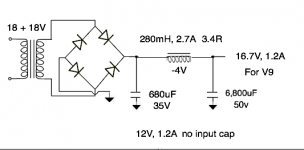Hello, I am building a 71a preamp, and it's coming along pretty well!
Right now I have about a 19V filament supply, and a 56R/12W resistor and it dials in the filaments almost exactly at 250mA and 14V bias. Works great!
But 100 year old tubes are impossible to match, and I was thinking of swapping the 56R for a 75R/12W and then putting a 500R/5W power rheostat or variable resistor in parallel. Or alternatively, keeping the 56R resistor and then putting a 20R power variable resistor in series.
This way I can match the tubes, or also play around with starving the filaments a bit to see what happens. I have a quantasylum distortion analyzer, so I can watch in real time and tune them carefully enough.
Thoughts on this, and also what types of variable resistors are good or bad for this application?
Thanks!
Right now I have about a 19V filament supply, and a 56R/12W resistor and it dials in the filaments almost exactly at 250mA and 14V bias. Works great!
But 100 year old tubes are impossible to match, and I was thinking of swapping the 56R for a 75R/12W and then putting a 500R/5W power rheostat or variable resistor in parallel. Or alternatively, keeping the 56R resistor and then putting a 20R power variable resistor in series.
This way I can match the tubes, or also play around with starving the filaments a bit to see what happens. I have a quantasylum distortion analyzer, so I can watch in real time and tune them carefully enough.
Thoughts on this, and also what types of variable resistors are good or bad for this application?
Thanks!
In this place even the "best of the world" potentiometer is cr.p.
Each filament biased ancient DH tube sensitive to almost anything which is part of the power supply-filament-filament bias resistor.
If you use potentiometer for matching, after it must to change pot to good resistor (for example non inductive wire-wound).
DH tube notoriously sensitive to RFI/EMI, radiated hum (even 20dB differentia between samples), so shielding sometimes need.
Each filament biased ancient DH tube sensitive to almost anything which is part of the power supply-filament-filament bias resistor.
If you use potentiometer for matching, after it must to change pot to good resistor (for example non inductive wire-wound).
DH tube notoriously sensitive to RFI/EMI, radiated hum (even 20dB differentia between samples), so shielding sometimes need.
Ok, Sounds like a non starter then. Will look for other options. Thanks!In this place even the "best of the world" potentiometer is cr.p.
Each filament biased ancient DH tube sensitive to almost anything which is part of the power supply-filament-filament bias resistor.
If you use potentiometer for matching, after it must to change pot to good resistor (for example non inductive wire-wound).
DH tube notoriously sensitive to RFI/EMI, radiated hum (even 20dB differentia between samples), so shielding sometimes need.
A make-before-break switch adding small resistor values?
Elna makes fine 10 pos rotary switches with gold contacts.
Incorporating a second switch you could address the second deck and so on.
Elna makes fine 10 pos rotary switches with gold contacts.
Incorporating a second switch you could address the second deck and so on.
A make-before-break switch adding small resistor values? Elna makes fine 10 pos rotary switches with gold contacts.
-
Needs to burn a few watts though.
Maybe I’ll just put a little trim adjustment on the input signal and call it a day
-
Needs to burn a few watts though.
Maybe I’ll just put a little trim adjustment on the input signal and call it a day
Need more like 10 ohms to make a difference to change from 250mA to 225mA for example. We're not talking source resistors here.
There is one alternative which I use from time to time, and that is using choke input filament supplies and varying a small input cap to get the voltage you want. I just did this today, in fact, on a 10Y build in filament bias. I needed 16.7V output to my Rod Coleman V9 regs. No input cap gave me 12V, 1,000uF gave me 18V and it turned out that 680uF gave me exactly 16.7V. You need the choke to do this, but a choke is a good idea anyway.


Very Interesting! Thanks for sharing AndyThere is one alternative which I use from time to time, and that is using choke input filament supplies and varying a small input cap to get the voltage you want. I just did this today, in fact, on a 10Y build in filament bias. I needed 16.7V output to my Rod Coleman V9 regs. No input cap gave me 12V, 1,000uF gave me 18V and it turned out that 680uF gave me exactly 16.7V. You need the choke to do this, but a choke is a good idea anyway.
View attachment 1092732
- Home
- Amplifiers
- Tubes / Valves
- Potentiometer with filament bias DHT